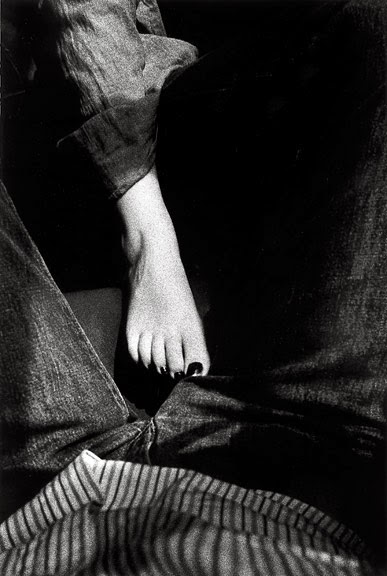Self-portrait Hotel Bijou Paris, 1973
Source: N.d. NIF Magazine. Web. 26 June 2014.
Helmut Newton, Portrait
Source: Egodesign. Web. 26 June 2014
Saddle I, Paris (at the Hotel Lancaster), 1976
Source: Christis's. Web. 26 June 2014.
Yves Saint Laurent, Vogue France, Rue Aubriot, Paris 1975
Source: Paris Vogue. Web. 26 June 2014
Yves Saint Laurent, Vogue France, Rue Aubriot, Paris 1975
Source: Paris Vogue. Web. 26 June 2014
Bergstrom, above Paris, Paris, 1976
Source: Paris Vogue. Web. 26 June 2014
Stern, Los Angeles, 1980
Source: Paris Vogue. Web. 26 June 2014
Sie Kommen (They are coming), Vogue France, Paris, 1981
Source: Paris Vogue. Web. 26 June 2014
Miami, Florida, 1978
Source: Christie's. Web. 26 June 2014
Vogue France, Paris, 1994
Source: Paris Vogue. Web. 26 June 2014
Born on October 23, 1920 to a
well-to-do button factory owning family, Helmut Newton’s childhood consisted of
traveling from his avant-garde prewar Berlin to the grandest hotels of Europe.
Ignoring his father’s warning that Helmut would “end up in the gutter because
his young mind was so singularly focused on girls and photographs” at age 12 he
bought his first camera, an Agfa Box. Four years later, at age 16, Newton
apprenticed with Elsie Simon aka Yva a theatrical and fashion photographer and
while there realized his dream to become a photographer for Vogue.
Unfortunately, due to the growing
anti-Semitic actions of Germany, in 1938 Newton and his family not only left
Germany but also went to separate countries, with Helmut heading to Singapore
and his parents to Chile. Yet, in 1940 the British government, deeming Newton
an “enemy alien” relocated him to Australia, where he spent two years in a camp
only to have the government release him to join the Australian Army. For Helmut the end of the war brought his Australian citizenship and freedom to return to
his passion.
Less than a year later, he opened
his first studio in Melbourne, Australia.
Here he discovered his knack for capturing fashion and
theater and in 1953 he premiered his first joint exhibition with Wolfgang
Shivers titled “New Visions in Photography”. “Newton helped transform fashion photography from
a mere photographic report of current styles to an alluring presentation
with mise-en-scène and a narrative.” According to
Newton “The 1960s and seventies was a most creative
time for fashion photography… We didn’t need money to produce our photographs.”
Newton took an artistic risk and choose to capture fashion from the gutters,
from the “realms of cocaine, Patty Hearst, lesbians, bondage, sadomasochism,
voyeurism, murder, pornography, prostitution, and threesomes.” His work
captured the new sexual revolution of the 60s and 70s in the liberated era. In
sum, his dreamlike works “were like a peep through a keyhole, spied moments of
heightened reality.” These works centered mainly on female nude models, but
Newton rejected the scrawny and plastic models in favor of lesser-known natural
amazon-esq models. In regards to location, Newton avoided studios and turned
towards mansions, hotels, or calf-decayed gardens and he preferred harsh glares
such as that of midday sun or nocturnal shots, which many of his photographs
portray. According to Anna Wintour, Newton’s innovative work is “synonymous
with Vogue at its most glamorous and mythic”.
On January 23, 2004,
the American-ized Newton passed away from a motor vehicle accident. Yet, his
innovative work lives on as does his inspiration. Photographers such as Ellen
von Unwerth, Deborah Tuveville, David Baily, Mario Testino, Steven Klein and
Herb Ritts each borrowed techniques Newton created. In addition, his aesthetic
influenced film directors such as Stanley Kubrick, Brain De Palma, and Roman
Polanski. While his sensibility can be found in designers, such as Yves Saint
Laurent, Helmut Lang, and Tom Ford. For example, in Ford’s fall 2003
collection, the Lucite jewelry was based on Ford’s memory of Newton’s
late-seventies series of naked women in orthopedic body braces. Helmut Newton
once wrote to a friend that photographers, like well-behaved children, should be
seen and not heard. Fortunately for posterity, his photographs have and
continue to speak volumes to this day.
Bibliography
"THE BAD AND THE BEAUTIFUL: Helmut Newton - ALVAR MAGAZINE." ALVAR
MAGAZINE THE BAD AND THE BEAUTIFUL Helmut Newton Comments. N.p., Sept. 2013. Web. 26 June 2014.
"Helmut Newton Biography." Annenberg Space for Photography. The Annenberg Space for Photography, 2014. Web. 26 June 2014.
"Helmut Newton." Voguepedia. Vogue, n.d. Web. 26 June 2014.




















































